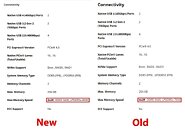- Joined
- Oct 9, 2007
- Messages
- 47,670 (7.43/day)
- Location
- Dublin, Ireland
| System Name | RBMK-1000 |
|---|---|
| Processor | AMD Ryzen 7 5700G |
| Motherboard | Gigabyte B550 AORUS Elite V2 |
| Cooling | DeepCool Gammax L240 V2 |
| Memory | 2x 16GB DDR4-3200 |
| Video Card(s) | Galax RTX 4070 Ti EX |
| Storage | Samsung 990 1TB |
| Display(s) | BenQ 1440p 60 Hz 27-inch |
| Case | Corsair Carbide 100R |
| Audio Device(s) | ASUS SupremeFX S1220A |
| Power Supply | Cooler Master MWE Gold 650W |
| Mouse | ASUS ROG Strix Impact |
| Keyboard | Gamdias Hermes E2 |
| Software | Windows 11 Pro |
A new ultraportable notebook model powered by the AMD Ryzen AI 300 series "Strix Point" processor coming this December, will feature LPDDR5X-8000 memory, a memory speed above the LPDDR5-7500 that was standard for the processor. Hoang Anh Phu did some digging, and found that AMD has quietly updated the product pages of these processors on its website, now showing support for LPDDR5X-8000. Older versions of these pages accessed by The Wayback Machine showed them to mention 7500 MT/s as the top speed for LPDDR5X.
While regular DDR5 SO-DIMM speeds remain unchanged at dual-channel DDR5-5600, it's pertinent to note that mainstream and enthusiast-segment gaming notebooks tend to use faster DDR5 SO-DIMMs than spec using OEM-level memory overclocking, however, LPDDR5X speeds do not tend to be higher than what the processor is capable of. An OEM would only use LPDDR5X-8000 chips if the processor officially supports it, which it now does with this stealthy specs update. The notebook in question is an HP EliteBook X G1a, a 14-inch premium ultraportable that not just uses LPDDR5X-8000 with "Strix Point" processors, but also seems to have overclocked its NPU. By AMD's specs, the XDNA 2 NPU should be capable of 50 TOPS, but HP has stepped its performance up by 10%.


View at TechPowerUp Main Site | Source
While regular DDR5 SO-DIMM speeds remain unchanged at dual-channel DDR5-5600, it's pertinent to note that mainstream and enthusiast-segment gaming notebooks tend to use faster DDR5 SO-DIMMs than spec using OEM-level memory overclocking, however, LPDDR5X speeds do not tend to be higher than what the processor is capable of. An OEM would only use LPDDR5X-8000 chips if the processor officially supports it, which it now does with this stealthy specs update. The notebook in question is an HP EliteBook X G1a, a 14-inch premium ultraportable that not just uses LPDDR5X-8000 with "Strix Point" processors, but also seems to have overclocked its NPU. By AMD's specs, the XDNA 2 NPU should be capable of 50 TOPS, but HP has stepped its performance up by 10%.


View at TechPowerUp Main Site | Source


